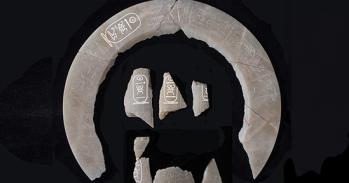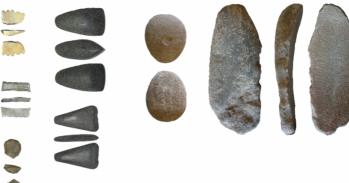
A major excavation at Britain’s biggest Iron Age hill-fort has begun in Somerset, in the hope that it will at last enable historians to explain the meaning and purpose of the enigmatic site.
A major excavation at Britain’s biggest Iron Age hill-fort has begun in Somerset, in the hope that it will at last enable historians to explain the meaning and purpose of the enigmatic site.
We don't know if the site's development was prompted by trade, defence or communal identity needs.
Christopher Evans
Stretching across a vast area measuring more than 80 hectares, Ham Hill dominates the landscape a few miles west of Yeovil. It is by far and away the largest hill-fort in the country, dwarfing better-known sites from the same period such as Maiden Castle, in Dorset, or Danebury in Hampshire.
Its sheer scale, however, also presents an historical puzzle. No Iron Age society could possibly have mustered enough people to defend such a huge site. Yet while it is therefore unlikely that Ham Hill functioned as a serviceable fort, nobody has to date been able to explain what it was used for.
Now a plan to expand a local quarry that harvests the site for its distinctive "hamstone", used in listed buildings around the south of England, has given archaeologists the chance to find out more. The researchers, a joint team from the Universities of Cambridge and Cardiff, will spend three seasons digging a hectare of Ham Hill's interior to try to understand more about its layout and use. This Saturday (September 3rd), they will also be holding an open day at the hill-fort, giving members of the public a chance to come and find out about what they have discovered so far.
"It's a bit of an enigma," Niall Sharples, from the School of History, Archaeology and Religion at Cardiff University, said. "Ham Hill is so big that no archaeologist has ever really been able to get a handle on it. As a result there has never been a thorough campaign of excavations and nobody knows how the settlement was organised inside."
"People think of these places as defensive structures, but it is inconceivable that such a place could have been defended. Thousands of people would have been required; militarily it would have been a nightmare. Clearly it was a special place for people in the Iron Age - but when did it become special, why, and how long did it stay that way?"
Researchers believe that the site may have functioned as a monument and was somehow meant to create a sense of community, collective identity, or prestige. Establishing this remains difficult, however, while so little is known about Ham Hill in more general terms. Although tentative excavations were carried out in the early 20th century, researchers are still unclear about fundamental issues, including when it was built. One of the key aims of the current excavation will be to try to pin down the rough date of the so-called hill-fort's construction.
This may prove easier said than done. Stone axe and arrow-heads, as well as an old field system, attest to some sort of use in the Neolithic period, and Bronze Age finds which would normally be found in hoards or burials have also been unearthed. As an Iron Age structure, Ham Hill may have been occupied during the first century BCE, before being taken over by the Romans some 200 years later.
It was the Romans who also started to quarry the site's distinctive, honey-coloured limestone. Initially this was used to make sarcophagi (Roman coffins), but later it was used for monuments and medieval houses which can still be found in parts of the south-west and along the south coast. Quarrying continued almost uninterrupted until the present day and the stone is still needed, not least for what are now historically valuable listed buildings. As a result, permission has been given for the quarry to expand, enabling the archaeological survey to take place.
The current excavation has already thrown up a number of finds. The initial dig uncovered human remains - one full skeleton and the partial remnants of perhaps two others - as well as the skeleton of a dog. All are still being studied and dated. The team also found more signs of domestic life - the remains of a house, pottery, iron sickles, quern stones, bill hooks and other objects dating back to before the Roman invasion.
At the moment archaeologists are focusing on a rectangular enclosure which was surrounded by a ditch, measuring about 100m by 60m. Several such paddocks appear to have existed, as well as at least one main thoroughfare and a scattering of roundhouses and grain storage pits. It is still unclear what the rectangular spaces were meant for. "Enclosures are not normally found inside hill forts of the Iron Age and it may be that this has a special place in its layout," Sharples said.
Work will continue until September 2013, by which time the team will also have examined some of the fort's massive ramparts and have a clearer map of its interior. A study of earlier finds from Ham Hill, many of which are now exhibited in Taunton Castle Museum, will also be carried out with a view to building up a picture of what life was like there more than 2,000 years ago.
"This is the first time we have been able to address Ham Hill's staggering size," Christopher Evans, from the Cambridge Archaeological Unit, University of Cambridge, added. "We don't know if the site's development was prompted by trade, defence or communal identity needs. Equally, should we be thinking of it as a great, centralised settlement place - almost proto-urban in its layout and community size? These are big issues to address and it is rare to have the time and resources to tackle them on the scale they deserve."
The open day at Ham Hill will run from 11am to 4pm on Saturday, 3 September. Site tours will also be held every Sunday to Thursday at 2.30pm.
This work is licensed under a Creative Commons Licence. If you use this content on your site please link back to this page.





